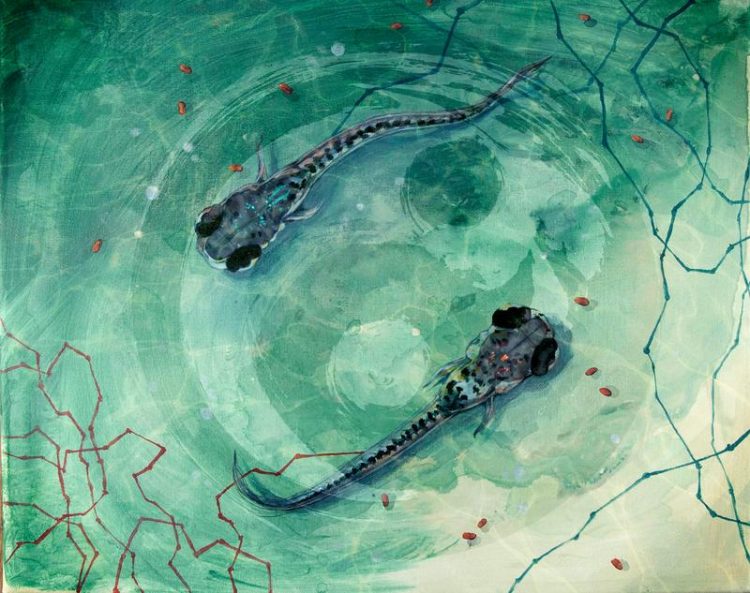Neuroscientists decipher a critical switch that controls brain state

Artwork of Larval Zebrafish Sarah Stednitz, Martin Vötsch / Max Planck Institute for Biological Cybernetics
An international team of brain researchers achieved a breakthrough in uncovering a switch-like mechanism that flips the brain between two motivational states in larval zebrafish, a model organism in neuroscience.
In one state, the fish slows down its movements and focuses on hunting for prey. In the opposing state, the animal speeds up and explores its environment. How the brain switches between states is a central mystery in neuroscience.
By observing the activity of every neuron in the brain during foraging, the team was also able to pinpoint a central hub of serotonin-producing neurons that may act as a master regulator of brain state. Their scientific discovery has now been published in the international journal Nature.
According to their study conducted at the Rowland Institute, Harvard University, there is an internal switch that flips the brain between two motivational states. The activity of this central hub they discovered is governed by a dynamical system that sets its timing and amplitude.
Neuronal hub coordinates the switch for brain state
In larval zebrafish, the researchers João Marques, Meng Li, Diane Schaak, Jennifer Li and Drew Robson identified two distinct brain states during foraging: exploitation and exploration. During exploitation, fish are highly focused and efficient hunters.
During exploration, fish are restless and inattentive to prey. As fish switch between these two states, their performance as hunters and attentiveness to prey change dramatically.
“The activity in this central hub we identified is remarkably persistent and asymmetric, peaking rapidly and decaying slowly. The timing of this signal corresponds precisely with the timing of changes in behavior,” explained Jennifer Li and Drew Robson, principal investigators of this study.
When the activity of this hub is high, the fish is a focused and effective hunter. When the activity relaxes, the fish transitions from exploitation to exploration, from a focused hunter to a restless one.
Discovery of an electrochemical clockwork in the brain
Using a tracking microscope, developed by the scientists themselves, it is possible to follow zebrafish behavioral phenomena such as switching brain states in the animal’s natural environment. The fish swim completely freely, without any impairment, while the scientists can see through the thin and transparent skin of the fish and analyze the activity of the brain cells precisely.
The results of their work reveal an important hidden variable, an electrochemical clockwork in the brain, that shapes the temporal structure of motivation and decision making. There is evidence that this mechanism for switching brain states is preserved throughout evolution.
A simplified version of this brain state switch may also control movement of worms, and a more complex form may coordinate cortical activity in mammals and possibly humans. Future studies will be needed to fully understand why and how this switching mechanism has been preserved across evolution.
About the principal investigators Jennifer Li and Drew Robson
Jennifer Li and Drew Robson have been working together for over a decade to achieve a systems-level understanding of how neural circuits are modulated by internal states and experience. Since 2014, Jen and Drew have led a joint laboratory together (rolilab.org), first as Rowland Fellows from 2014 to 2019 at Harvard University and now as Max Planck Research Group Leaders at the Max Planck Institute for Biological Cybernetics in Tübingen, Germany.
Jennifer received her B.A. in Molecular Biology from Princeton University, where she worked on developmental biology in the Wieschaus lab. She received her Ph.D. from Harvard University, where she did research on operant learning and brain-wide neural imaging in the labs of Schier and Engert.
Drew received his B.A. in Mathematics from Princeton University, where he also worked on computational biology and biophysics in the labs of Olga Troyanskaya and Eric Wieschaus. He received his Ph.D. from Harvard University, where he did research on thermosensory behaviors and brain-wide neural imaging in the Schier and Engert labs.
This study has been conducted at the Rowland Institute, Harvard University, Cambridge, Massachusetts, USA. Please also note a related article that is planned to be published online at The Harvard Gazette.
Jennifer Li, PhD
Research Group Leader
Max Planck Institute for Biological Cybernetics
Phone: +49 7071 601 1601
eMail: jennifer.li@tuebingen.mpg.de
Drew Robson, PhD
Research Group Leader
Max Planck Institute for Biological Cybernetics
Phone: +49 7071 601 1602
eMail: drew.robson@tuebingen.mpg.de
DOI: 10.1038/s41586-019-1858-z
Media Contact
All latest news from the category: Life Sciences and Chemistry
Articles and reports from the Life Sciences and chemistry area deal with applied and basic research into modern biology, chemistry and human medicine.
Valuable information can be found on a range of life sciences fields including bacteriology, biochemistry, bionics, bioinformatics, biophysics, biotechnology, genetics, geobotany, human biology, marine biology, microbiology, molecular biology, cellular biology, zoology, bioinorganic chemistry, microchemistry and environmental chemistry.
Newest articles

First-of-its-kind study uses remote sensing to monitor plastic debris in rivers and lakes
Remote sensing creates a cost-effective solution to monitoring plastic pollution. A first-of-its-kind study from researchers at the University of Minnesota Twin Cities shows how remote sensing can help monitor and…

Laser-based artificial neuron mimics nerve cell functions at lightning speed
With a processing speed a billion times faster than nature, chip-based laser neuron could help advance AI tasks such as pattern recognition and sequence prediction. Researchers have developed a laser-based…

Optimising the processing of plastic waste
Just one look in the yellow bin reveals a colourful jumble of different types of plastic. However, the purer and more uniform plastic waste is, the easier it is to…



